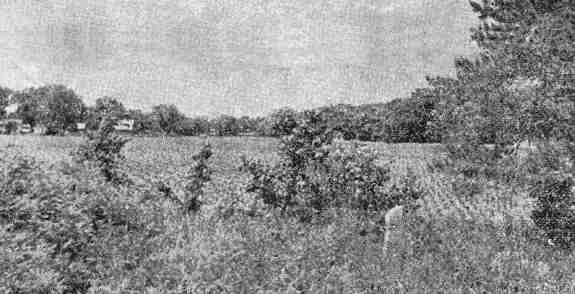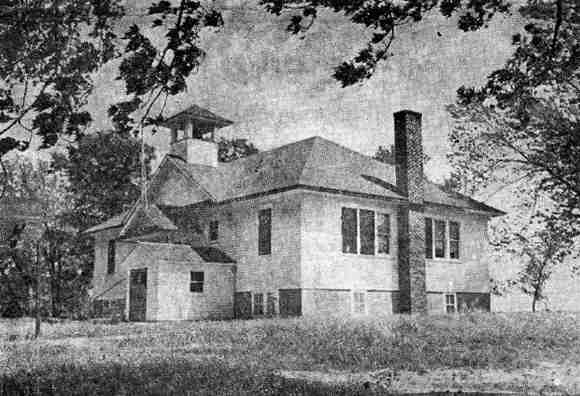ONCE THRIVING RAILROAD TERMINAL
By Mrs. Clyde Roehr
Mitchell County Press News June 27, 1957
Most motorists driving north on highway 218 in Mitchell county, one mile south of the Iowa-Minnesota line, perhaps scarcely notice the town of Mona. It isnít even marked by a sign, although it is found on some maps.Mona isnít the promising town it once was back in the 1800ís; in fact when it was started it was named Hustad after the P.K. Evenson family name, and also the Hustad post office which was located in the general store.
According to records, the town was platted in 1869, shortly after the
railroad arrived. The land was first the property of George Briggs and C.H. Gregory, land speculators, and no buildings were there until the depot was erected. The railroad line between Cedar Falls and Mona was built between 1865 and 1870 by the Cedar Falls and Minnesota Railroad company.

One of the town's old timers, who still remembers when Mona was in it's hey-day, is Alfred Larson, custodian for both the Mona school and Mona church. He is shown here with a Mona school enrollment slip, issued when he was a youngster, in 1895.
Mona remained the northern terminus until 1900 when it was extended to Albert Lea (MN). First depot was a two story building, later sold and replaced by a boxcar body.
In 1868 a two stall frame engine house was built in St. Ansgar, moved to Mona in 1870 and sold in 1896. After the roundhouse, there was erected on the Illinois Central, the water tower, water softener for the engines and pumping station for the railroad were built and the town began to grow. Mona became a notable railroad terminal.
Just shortly before the railroad had reached Mona, Charles Hughitt and J.D. Farley purchase all the land and platted much of it into lots and blocks. The town was originally ten blocks long and three and a half blocks wide, with each street named.The main street was named Farley Street. Only one building on the original main street remains today and is the home of the Lavern Anderson family. Now only one third of the town south of Main street remains in lots. Everything north is either farm land or part of the highway.
Some of the early buildings erected were the general store and post office, combined which burned in 1880. It was replaced and more buildings
followed, when two more railroads arrived, the Chicago-Milwaukee and the St. Paul Railway.

This building, now a chickenhouse on the Harvey Goldberg farm at Mona, was the community's first school. It was first used as a school in 1890, and was enlarged in 1899. A second school, a two room building was later built on the same site, but burned down in 1922. The present school was built shortly after that.
Monaís first hotel was erected in 1869 by Mr. Crowell and in 1883 there were two hotels, the second one run by Mrs. A.A. Merrick and Mrs. E.M Wheeler. Later came the first blacksmith shop, started by Mr. Clark.
Other business buildings were the Frank Penney and J/P. Farley general merchandise store, lumber and coal dealers also run by Farley and Penney; S. A. Sanford, P.K. Everson and A.B. Pike attended the grain trade in the townís elevator. There was also a saloon and was operated by James Oleson.
A creamery was started in 1883 by the Penney brothers. During summer months, 17 teams and cream haulers covered a distance of ten miles square gathering cream.
During the first six months of operation, an average of 9.000 pounds of butter was made monthly. This continued for a period of ten years. Butter fat at that time sold for 27 cents a pound.
Mona also had a doctor, Dr. W.F. Cobb, who started his practice there following graduation from Chicago Medical College. He also owned and managed
a drug store. He practiced in his home, and the original house in the west part of Mona is still in use, owned by the Norman Strouf family.

The Mona cemetery, unkempt and nearly forgotten, overlooks a field of corn on the Harvey Goldberg farm south of Mona. The cemetery, once connected with the town by a street, is now centered in a cornfield. In the background is the farm's building cluster.
He also started the first Sunday school in the school house before the Lutherans organized a congregation.
Some of the other places of business were a hardware store, a furniture store, a millinery shop, stockyards and a dance hall.One settler tells of letting his grain stand in stocks over a year until a threshing machine could be engaged in Mitchell County. After the railroad arrived many settlers no longer had to make the long journey to McGregor.
In 1871 when the railroad was built north of Mona, many changes took place, and with the passing of years and changes in trade centers, abandonment of saloons and other causes, one mile north, which later became the railroad center. Soon homes that hadnít burned down were moved. The old Lon Penney home was moved to the Martin Robertson farm and is still used as a home.
Today there is only one small grocery store, operated by Mrs. Adeline Geffert; a school, church and 19 homes with a population of 66 residents. Many of the residents either work for Hormelís in Austin (MN) or for the railroad.
Mona received its present name from William C. Caine who came here from the Isle of Mann, in the British Isles. He named it after his sweetheart,
Ramona Johnson, who died after a broken romance.

The Mona Lutheran church is the only relgious structure that the town has ever had. It underwent interior redecoration recently. The structure was built in 1882. Mona is still a predominantly Lutheran community.
Caine owned many acres of land south of Mona and owned much livestock. He lived in a small house behind the woods on his farm, now part of the Tom Wamstad and Louis Solo Farms.
Part of the original farm is now the Pleasant Hill cemetery, which was bought from Caine in 1894. It was Caineís wish that when he died, he be buried on his own land. He picked the spot and planted birch treeís on the site which was at that time was outside the cemetery plot.
Later, more ground was needed and today, his grave and lot is in the center of the cemetery. After his death, a nephew came from Ireland to settle the estate and enroute home he lost his life by shipwreck. It wasnít until 1910 that the Canine land was deeded to Mrs. Elizabeth Joughlin (widow in England). It was later sold to McGillvary and Sawyer.
Monaís first cemetery was connected with the town and was public burial ground. It was given to the town by J.P. and Mary Farley in 1879. It is now surrounded by farming land on the Harvey Golberg farm and the old road leading to it has been closed. No one has cared for in it the past few years and it has grown up into brush and trees.
The second cemetery was started by the Mona Lutheran congregation and was named Oak Lane. It is located on the main road east of Otranto. There have been no burials in either for many years.
The congregation in 1894 purchased the ground from Caine for the present Pleasant Hill cemetery, with Gustave Carlson being its first caretaker.
The Mona Lutheran organized a congregation in September, 1876 and in the fall of 1882 built a church which is still in use. It is the only church Mona has ever had. The 75th anniversary of the church was celebrated with a rededication last month. In 1910, 38 families withdrew and organized a church in Lyle, known as Our Savior Lutheran.
Mona has had three school houses, all on the same site. The first one was begun when S.C. Rustad moved at a board meeting that a school be built in the spring of 1890, with an eight month school term. In 1899 it was enlarged. H.C. Ackerman was hired to teach higher grades for $38.00 a month. The primary department was taught Mrs. Jennie Rustad for the spring terms of 10 weeks at $20.00 a month.

The Mona community's 30 grade school students have ample room for study in the Mona schoolhouse, pictured above. The school is a two room structure and is the third that has served the community. It is situated at the southern extremity of the town. Teachers at the school for the 1957-58 term will be Mrs. Denver Osmonson of Lyle and Adeline Lastine of Rose Creek, Minn.
In the records of 1890 it was found that if a pupil was absent or tardy three times without a reasonable excuse by parents. The pupil had to appear before a committee appointed by the board to be readmitted.
Another item in the school records was a bill presented by Dr. W.F. Cobb, also school secretary for many years, for the some of $2.50 for sawing and splitting a cord of wood for school kindling and hauling away the banking from School.
In 1899 it was decided to build a larger school and to room school was completed in September, 1899 for $1,400 to seat 100 pupils. The bids went to local carpenters, Lund and Hume, S.J. Peshak was awarded $25.00 to move the old school away, which is still being used as a chicken house on the Harvey Golberg farm.
In 1900, school continued until July 4. In 1908, records show that 155 pupils attended. That same year a well was drilled on the school grounds. This school burned in 1922. Sparks from a passing train were thought to have started the blaze. The present school was erected soon after and has been modernized in recent years.
The only native Mona resident is Clara Christianson, who was born there and has lived her entire life in the same house.
Transcribed and Edited by: Neal Du Shane 12/10/2006
HTMLization by Kermit Kittleson, Dec. 2006